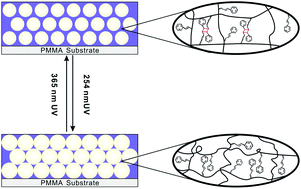Controllable photo-switching of cinnamate-based photonic films with remarkable stability
Abstract
In this work, a

* Corresponding authors
a
School of Materials Science and Technology, China University of Geosciences, Beijing, P.R. China
E-mail:
zyh@cugb.edu.cn
b
Key Lab of Organic Optoelectronic and Molecular Engineering, Department of Chemistry, Tsinghua University, Beijing, P. R. China
E-mail:
LGT@mail.tsinghua.edu.cn
Tel: (+) 10-62792905
In this work, a

 Please wait while we load your content...
Something went wrong. Try again?
Please wait while we load your content...
Something went wrong. Try again?
X. Li, J. Cui, W. Zhang, J. Huang, W. Li, C. Lin, Y. Jiang, Y. Zhang and G. Li, J. Mater. Chem., 2011, 21, 17953 DOI: 10.1039/C1JM11708D
To request permission to reproduce material from this article, please go to the Copyright Clearance Center request page.
If you are an author contributing to an RSC publication, you do not need to request permission provided correct acknowledgement is given.
If you are the author of this article, you do not need to request permission to reproduce figures and diagrams provided correct acknowledgement is given. If you want to reproduce the whole article in a third-party publication (excluding your thesis/dissertation for which permission is not required) please go to the Copyright Clearance Center request page.
Read more about how to correctly acknowledge RSC content.
 Fetching data from CrossRef.
Fetching data from CrossRef.
This may take some time to load.
Loading related content
